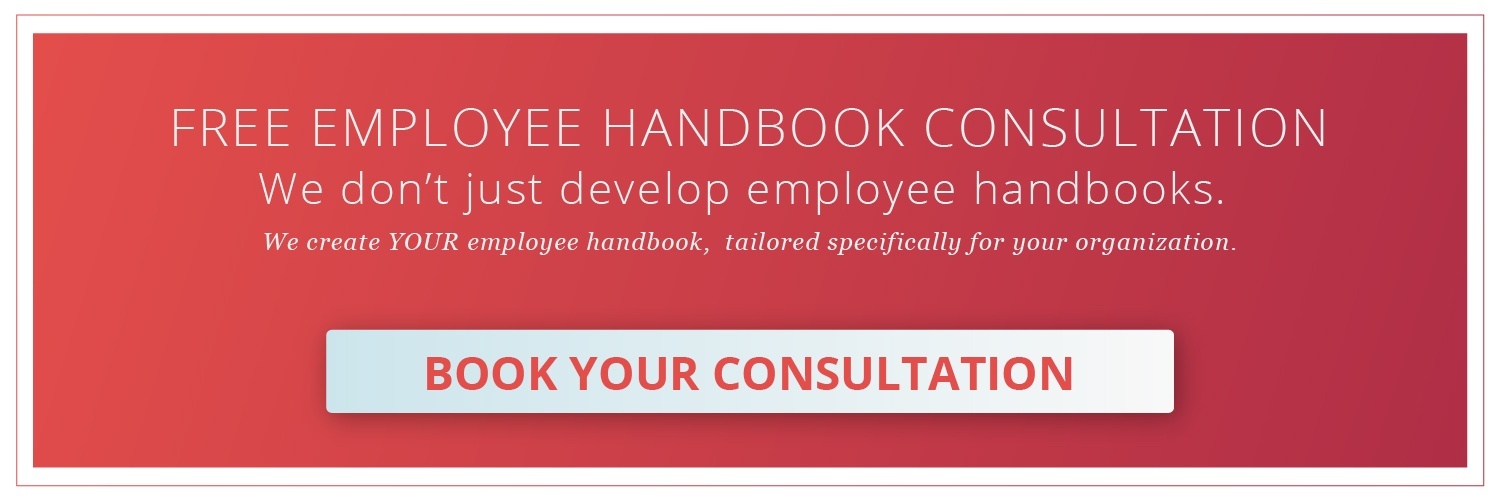Every new hire needs guidance and information, and a resource to go to for that. But too many employers fail to provide a functional employee handbook for their new staff members.

It's a fact that many businesses do not have a employee policy manual, or handbook. In addition, many do not have any type of new hire onboarding process or even documented employee termination procedures. Yet it is these very tools and processes that are needed for avoiding costly employee lawsuits.
Employee Handbook Basics
Keep in mind that neither state nor federal law requires an employee handbook. However, if you choose to provide one, the state will often have requirements around that, as in California, for example. According to CalChamber,
"California does not require employers to have a handbook. However, if you create a handbook, there are policies that must be included."
Before we look at these policies, there are some basic points that must be considered first. One of the things you need to determine is what to call your employee handbook. It seems that most organizations do simply refer to it as an employee, or company, manual or handbook. But this not required nor even the best choice.
By making the document more accessible and interesting with an engaging title, or name, you will improve the odds of your employees actually reading through it. Unfortunately, even though most companies require their staff to sign and date a form stating they've read the handbook, there will always be those who don't regardless.
Call your handbook something like the Team Guidebook or the Company Culture Manual. Have a contest for naming it or stage a raffle by pulling a name out of a box. The goal is create a document that will be engaging for your staff and one that embodies the culture of your company.
A second fundamental step is to include your company vision and mission statement in the preface of your handbook. This is a great way to remind your employees of the values and goals of your organization. it can also serve to provide the high-level purpose of an employee handbook. Using this venue to communicate your company's vision, mission, and company values, will help to provide a relevant context for your policies.
Which leads to a third point: Your employee, or policy handbook, serves to present your company's policies. Nothing else. The problem for many organizations is that their manuals contain far too much information. They are often referred to as their "Policies and Procedures" manuals. But a company's procedures are better off placed in their own set of documents - either printed or digital - and separate from the company's policies.
Labor Law Compliance and Your Employee Handbook
As we've noted previously, neither the federal government nor the state of California requires businesses to have an employee or policy handbook.
However, keep in mind that if a California employer creates a manual or handbook then there are certain policies that must be included.
According to CalChamber,
Certain policies are mandatory and must be included in your employee handbook. For example, California employers must have a written harassment, discrimination and retaliation prevention policy. Including these policies clarifies for employees their rights and obligations, and protect you from potential liability.
An employee policy handbook is a great tool for explaining and clarifying a company's policies. However, if it is not done properly it can actually lead to potential lawsuits. It is essential to confirm that any company policies documented do not violate any federal or state laws. For example, in California you must be careful that policies do not override the at-will employment relationship.
Best Practices for Your Employee Handbook
Some "best practices" for creating an effective employee handbook include the following items:
Have clear but essential policies
Company policies should be clear, concise and reasonable. Every policy should be reviewed by management with this end in mind. Of critical importance are policies outlining disciplinary actions that can be taken by the company. It is not necessary to create a policy for everything. Your employees ought to be expected to conduct themselves reasonably and with a shared sense of mutual respect.
Avoid excessive legal language
An employee handbook should be written in succinct, concise and clear language. It is not required to mention or document every labor law issue that might be relevant. It is a source of guidance and information and the purpose is to communicate this clearly.
Define acceptable digital practices
Digital media and the constant need for security makes this is a high priority company policy issue. This means that a comprehensive overview of your company's accepted digital use and practices is essential. It should include acceptable Internet use at work, and what can be posted personally and on behalf of the company.
While every company handbook will be unique due to the unique nature of policies, etc. there are some common items that should be included, as well.
According to the SHRM,
Important factors to consider are legal mandates for federal and state laws that affect employees, such as the Family and Medical Leave Act, COBRA, Equal Employment Opportunity Commission (EEOC) anti-discrimination laws, the Americans with Disabilities Act, and the Fair Labor Standards Act. If an employer fails to communicate these in the employee handbook, there may be confusion and noncompliance with the laws.
In addition to the policies and practices that every employee should know and understand, once an organization chooses to have an employee, or policy, handbook there may be required information that is needed.
CalChamber notes that,
"In addition to the mandatory policies, there is certain information that must be communicated to employees. The information may be required in your employee handbook and/or the posters you hang in communal areas. Other information must be given to employees at the time of hire or at certain points during the employment relationship."
It might not be a good idea to rely strictly on having a digital copy of your handbook for employees. There are many instances where have a printed, bound copy for every employee will ensure that they literally have the policies "at hand."
Professional Help for Your Employee Handbook
An updated and compliant employee handbook will help your organization meet its obligations, while providing information for your staff and management. It's not enough to simply understand new laws and keep good records. Keeping your employees properly informed will help you make compliance a sure thing.
Another key step in maintaining HR compliance and increasing your company's cost-effectiveness is to consider outsourcing. A professional agency such as Accuchex can provide much-needed help with Human Resources needs and questions.
Accuchex is a full spectrum Payroll Management Services provider offering expertise in Time Management, Insurance and Retirement issues, as well.




